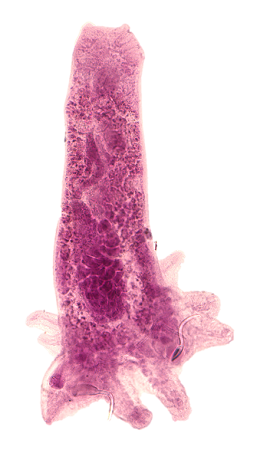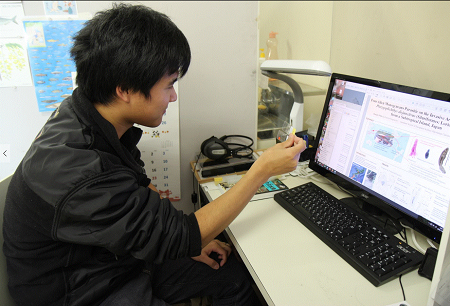By Caitlin E. Devor
Originally Published November 25, 2016
Hiroshima University scientists have identified a new species of parasite infecting an invasive freshwater fish on the subtropical island of Okinawa, Japan. The results are part of a project to find parasites that have arrived in Japan with their non-native hosts and understand the role of parasites in natural ecosystems. Tracking parasites can be one scientific method to monitor ecosystem health and attempt to conserve biodiversity.
The project began in 2012 when one of the researchers was trying to fill some of his free time. Masato Nitta, now a second-year PhD student at Hiroshima University, recognized some invasive fish in the stream that runs through the campus of the University of the Ryukyus in Okinawa, Japan, the university that hosted his research team during their field studies.
“It was just for play, not for official study. I saw two of the invasive catfish and I decided to try to catch them and check what parasites they had because I was curious. When I put the parasites under the microscope, they looked a little bit strange. No one had seen these parasites in Japan before,” said Nitta.
Nitta and his supervisor, Kazuya Nagasawa, PhD, from the Graduate School of Biosphere Science at Hiroshima University, returned to Okinawa in 2015 to study the parasites of the invasive vermiculated sailfin catfish in more detail. Their latest research paper announces a species new to science, two species found in Japan for the first time, and confirms the presence of the species they identified in 2012. The four species described in the research paper infect the gills of the catfish and are in the class Monogenea.
Only one species of monogenean is known to infect mammals, specifically the eyes of hippopotamus, so there is no record and little reason to suspect that the parasites pose any danger to humans directly. These foreign parasite species are most likely not a threat to Japan’s native freshwater fish because monogeneans are known to be very specific to their host species and spend their entire lifecycle in a single host.
The catfish species that hosts the parasites is native to the Amazon River and likely arrived in Japan in the 1980s by way of southeast Asian countries as part of the pet trade. The fish is sometimes eaten for food in Brazil, but is considered an ornamental fish in Japan. Even in its native habitat, the catfish’s normal parasitic infections are not well studied.
“I want to go to Brazil to do the work! But when I speak with local scientists, they tell me that no one can go so far into the jungle to find these fish in their natural habitat. But still, it is one of my dreams,” said Nitta.
The invasive species of freshwater catfish is Pterygoplichthys disjunctivus (Siluriformes: Loricariidae). The four species of monogenean parasite described in the research paper are: Unilatus brittani, Unilatus unilatus, Heteropriapulus heterotylus (first identified in Japan in 2012), and Trinigyrus peregrinus (new species identified in 2015). The results are published in the November 2016 issue of the journal Species Diversity, published by the Japanese Society of Systematic Zoology.
 |
| Trinigyrus peregrinus, new parasite species first identified in 2015 by Hiroshima University researchers |
IMAGE 1 CAPTION: Masato Nitta, a PhD student in the Graduate School of Biosphere Science, named the species “peregrinus” meaning “foreign or exotic” in Latin, referencing the likelihood that the species is not native to Japan. An average fully-grown adult’s body is approximately 0.65 millimeters (647 micrometers) long. For comparison, a Japanese 1-yen coin is about 1.5 millimeters thick. The pink color of the image comes from a staining solution (alum carmine) used to examine the parasite under a microscope. The parasite infects the vermiculated sailfin catfish, which is native to Brazil and now common as an invasive species in the freshwater rivers of Okinawa, Japan.
IMAGE 1 CREDIT: Image by Masato Nitta, Hiroshima University.
IMAGE 1 LICENSE: Image may only be re-used with attribution to Masato Nitta, Hiroshima University.
|
|
| Masato Nitta of Hiroshima University checks slides of a new species of parasite he identified during field work in Okinawa, Japan. |
IMAGE 2 CAPTION: Identifying the parasites of invasive species is one method to measure biodiversity and track ecosystem health. The parasites identified by Hiroshima University scientists infect the vermiculated sailfin catfish species Pterygoplichthys disjunctivus (Siluriformes: Loricariidae) native to the Amazon River and invasive in the freshwater river system of Okinawa, Japan. Nitta has found a new species, Trinigyrus peregrinus (new species identified in 2015), as well as three species not previously seen in Japan, Unilatus brittani, Unilatus unilatus, and Heteropriapulus heterotylus (first reported in 2012). The results are published in the November 2016 issue of the journal Species Diversity, published by the Japanese Society of Systematic Zoology.
IMAGE 2 CREDIT: Image by Caitlin E. Devor, Hiroshima University.
IMAGE 2 LICENSE: Image may only be re-used with attribution to Hiroshima University.
Full Citation of Current Paper:
Title: Four alien monogeneans, including Trinigyrus peregrinus n. sp., parasite on the invasive armored catfish Pterygoplichthys disjunctivus (Siluriformes: Loricariidae) from Okinawa-jima Island, Okinawa prefecture, Japan
Journal: Species Diversity (2016)
Authors: Nitta M, Nagasawa K.
DOI:10.12782/sd.21.2.095
Full Citation of Previous Paper:
Title: First Japanese Record of Heteropriapulus heterotylus (Monogenea: Dactylogyridae), from the Alien Catfish Pterygoplichthys disjunctivus (Siluriformes: Loricariidae) in Okinawa.
Journal: Species Diversity 18: 281-284. (2013)
Authors: Nitta M, Nagasawa K.
DOI: 10.12782/sd.18.2.281
Media Contact:
Masato Nitta, PhD
Graduate School of Biosphere Science, Hiroshima University
licht.bsn.mono*gmail.com (Please change * into @)


 Home
Home


